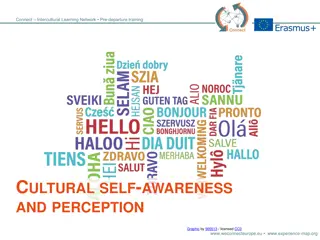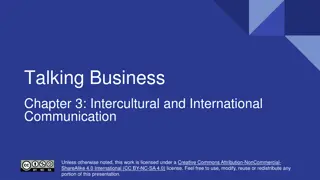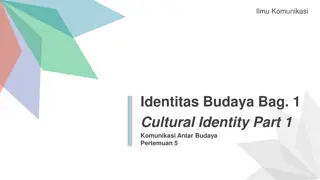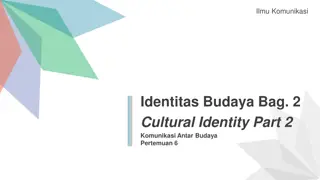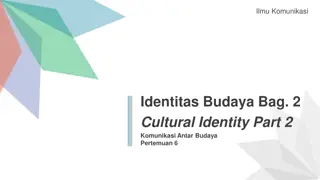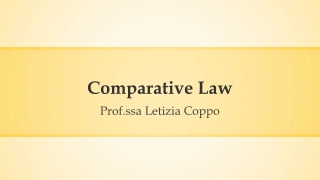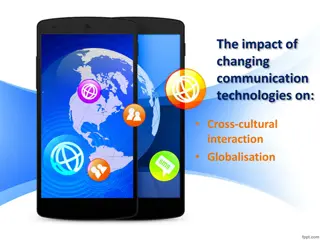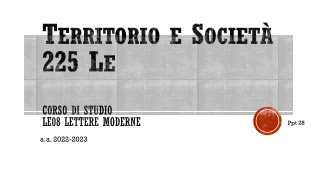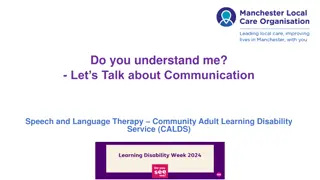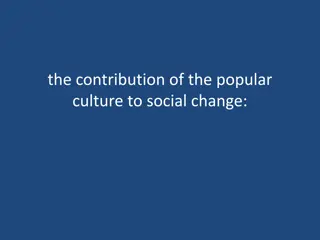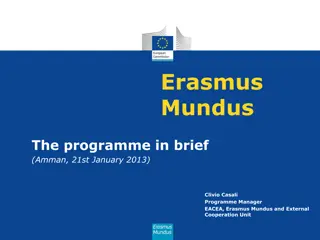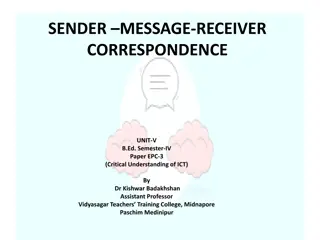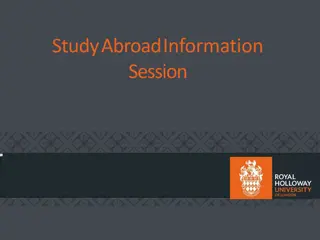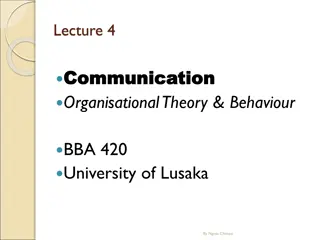Understanding Intercultural Communication in a Globalized World
Explore the significance of intercultural communication in various aspects such as globalization, world trade, technology, and environmental challenges. Learn about the dynamics between dominant cultures and co-cultures, the importance of studying intercultural communication, and the evolving nature of family structures in a globalized society.
Download Presentation

Please find below an Image/Link to download the presentation.
The content on the website is provided AS IS for your information and personal use only. It may not be sold, licensed, or shared on other websites without obtaining consent from the author. Download presentation by click this link. If you encounter any issues during the download, it is possible that the publisher has removed the file from their server.
E N D
Presentation Transcript
REVIEW Komunikasi Antar Budaya Pertemuan 7
The reasons of Learning Intercultural Communication Globalization World Trade and International Business Technology and Travel Competition for Natural Resources International Conflict and Security Environmental Challenges World Health Issue Shifting Population Immigration The aging population Multicultural Society Samovar et all. 2010. Communication Between Cultures
Samovar et all. 2010. Communication Between Cultures What is Intercultural Communication? Intercultural communication occurs when a member of one culture produces a message for consumption by a member of another culture. Intercultural communication involves interaction between people whose cultural perceptions and symbol systems are distinct enough to alter the communication event.
Samovar et all. 2010. Communication Between Cultures The Dominant Culture Co-Culture Within the dominant culture, you will find numerous co-cultures and specialized cultures. This is the group that usually has the greatest amount of control over how the culture carries out its business. Some co-cultures share many of the patterns and perceptions found within the larger, dominant culture, but their members also have distinct and unique patterns of communication that they have learned as part of their membership in the co-culture. This group possesses the power that allows it to speak for the entire culture while setting the tone and agenda that other will usually follow They control religious institution, media, government, education, military, etc. These co-cultural affiliations can be based on race, ethnic, gender, age, sexual preference, etc.
Samovar et all. 2010. Communication Between Cultures Studying Intercultural Communication Individual uniqueness Stereotyping Objectivity Communication is not a Cure-all
Samovar et all. 2010. Communication Between Cultures Forms of Family Nuclear Family Extended Family Changing Families in the world Globalization and Families Mass Media Immigration
Samovar et all. 2010. Communication Between Cultures Functions of the Family Reproduction Teaching economic values Socialization Teaching core values and worldview Identity development Communication training
Samovar et all. 2010. Communication Between Cultures Cultural Variants in Family Interaction Gender Roles Changing Gender Roles Individualism and Collectivism Age Grouping Social skills
Samovar et all. 2010. Communication Between Cultures Worldview The way people interpret reality and events, including images of themselves and how they relate to the world around them. (Peoples & Bailey) Worldview is a culture s orientation toward God, humanity, nature, question of existence, the universe and cosmos, life, moral and ethical reasoning, suffering, death, and other philosophical issues that influence how its members perceive their world. (Ishii, Coke, Klopf)
Samovar et all. 2010. Communication Between Cultures The Importance of Worldview Perception of women Perception of nature Produce different attitudes toward nature Perception of business
Samovar et all. 2010. Communication Between Cultures Forms of Worldview Religion as worldview Secularism as worldview Spirituality as worldview
Samovar et all. 2010. Communication Between Cultures Religion The Enduring Significance of Religion It has been linking people together while creating and preserving their cultures worldviews. Perhaps religions most enduring aspect has been its attempt to address questions about mortality and immortality, suffering, and the origin of the universe. Mechanism of social control Religion and the Study of Intercultural Communication Religion and behavior The study of religion in the 21st Century
Samovar et all. 2010. Communication Between Cultures Religious Similarities Speculation Sacred Scriptures Rituals Ethics Safe Haven
The Importance of Identity Identity development plays a critical role in the individual s psychological well-being. 1 An understanding of identity is also an essential aspect of the study of intercultural communication 2 The unsettled world that we all live in is in part influenced by adherence to varying perceptions of identity 3 Identity influences and guides expectations about your own and others social roles, and provides guidelines for your communication interaction with others. 4 Samovar et all. 2010. Communication Between Cultures
Selected Social Identities Remember! We have more than one identity. 01 02 Racial Identity Ethnic Identity - Mongoloid - Caucasoid - Negroid - Capoid - Australoid Derived from a sense of shared heritage, history, traditions, values, similar behaviors, area of origin, and in some instances, language. 03 04 Gender Identity National Identity The meanings and interpretations we hold concerning our self-images and expected other-images of femaleness and maleness . (Ting- Toomey) Refers to your nationality Samovar et all. 2010. Communication Between Cultures
Selected Social Identities Remember! We have more than one identity. 05 06 Regional Identity Organizational Identity Every country can be divided into a number of different geographical regions, and often these regions reflect varying cultural traits. In some cultures, a person s organizational affiliation can be an important source of identity. 07 08 Personal Identity Cyber and Fantasy Identity Consist of those characteristics that set one apart from others in his or her in-group, those things that make one unique, and how one sees oneself. The internet provides an opportunity to escape the constraints of everyday identities. (Suler) Samovar et all. 2010. Communication Between Cultures
Acquiring and Developing Identities Three-stage Model from Phinney Final stage Second stage Ethnic Achievement First stage Ethnic identity search Unexamined ethnic identity Samovar et all. 2010. Communication Between Cultures
Acquiring and Developing Identities Four-stage Model from Martin and Nakayama Final stage Third stage Integration Second stage Resistance and separatism First stage Conformity Unexamined identity Based on how they were achieved, your identities can also be classified as ascribed or avowed. This refers to whether your identities were obtained involuntarily or voluntarily. Samovar et all. 2010. Communication Between Cultures
LEARNING STEREOTYPES When do we learn stereotypes? Remember, you are not born with stereotypes; they are learned, and like culture, they are learned in a variety of ways. The most obvious, and perhaps most important, agent of stereotypes is the socialization process, which begins with our parents. While many parents try to avoid teaching their children to think in stereotypes, we tend to agree with Schneider when he notes that often parents directly or indirectly actually promote them. Many stereotypes are generated by the mass media and widely disseminated through a variety of formats such as advertisements, movies, and TV sitcoms, soap operas, and reality shows. Television has been guilty of providing distorted images of many ethnic groups, the elderly, and gay people. Media has also played a role in perpetuating certain stereotyped perceptions of women and men. Samovar et all. 2010. Communication Between Cultures
The Dark Side of Identity Prejudice Prejudice occurs when a person holds a generalization about a group of people or things, often based on little or no factual experience. Prejudice can be positive (liking a certain group or thing) or negative (disliking a certain group or thing). The Functions of Prejudice (1) The ego-defensive function allows individuals to hold a prejudice while denying to themselves that they possess negative beliefs about a group. (2) The utilitarian function permits people to believe that their prejudicial beliefs produce a positive outcome. This is often found in situations where economic gain is involved. In a communication setting, according to Ruscher, the negative feelings and attitudes held by those who hold a prejudicial perspective are often exhibited through the use of group labels, hostile humor, or speech that alleges the superiority of one group over another. (3) The value-expressive function occurs when people maintain their prejudice in the belief that their attitudes represent the highest and most moral values of the culture. (4) The categorize, organize, and construct their perceptions of other people in a manner they see as rational even if that perception is woefully inaccurate. knowledge function enables people to Samovar et all. 2010. Communication Between Cultures
EXPRESSIONS OF PREJUDICE First, prejudice can be expressed through what Allport refers to as antilocution, which involves talking about a member of the target group in negative and stereotypical terms. The fourth level of prejudice involves physical attacks, which often escalate in hostility and intensity if left unchecked. The fifth, and most alarming, form of prejudice is extermination. This expression of prejudice leads to acts of physical violence with the objective of removing or eliminating all or major segments of the target group community. Second, people act out prejudice through avoidance. This occurs when people avoid and/or withdraw from contact with the disliked group. Third, when discrimination is the expression of prejudice, the prejudiced person will attempt to exclude all members of the group in question from access to certain types of employment, residential housing, political rights, educational and recreational opportunities, churches, hospitals, or other social institutions. Samovar et all. 2010. Communication Between Cultures
CAUSES OF PREJUDICE (1) Societal sources: A great deal of prejudice is built into the major organizations and institutions of a society. According to Oskamp, these organizations produce norms, rules, regulations, and laws that give rise to societal prejudice and help maintain the power of the dominant groups over subordinate ones. (2) Maintaining social identity: At the beginning of this chapter we pointed out the important role that identity plays in connecting people to their culture. This link is very personal and emotional because it creates the bond that binds people and culture together. (3) Scapegoating: Scapegoating occurs when a particular group of people, usually a minority, is singled out to bear the blame for certain events or circumstances, such as economic or social hardships, that adversely affect the dominant group. Samovar et all. 2010. Communication Between Cultures
The Dark Side of Identity Racism Racism is the belief in the inherent superiority of a particular race. It denies the basic equality of humankind and correlates ability with physical composition. Thus, it assumes that success or failure in any societal endeavor will depend endowment rather than environment and access to opportunity. ~ Leone upon genetic The idea of superiority allows one group of people to mistreat another group on the basis of race, color, national origin, ancestry, religion, or sexual preference. Samovar et all. 2010. Communication Between Cultures
The Dark Side of Identity Ethnocentrism Ethnocentrism is the notion that one s own culture is superior to any other. It is the idea that other cultures should be measured by the degree to which they live up to our cultural standards. We are ethnocentric when we view other cultures through the narrow lens of our own culture or social position. ~ Nanda and Warms. Samovar et all. 2010. Communication Between Cultures
CHARACTERISTICS OF ETHNOCENTRISM Ethnocentrism Contributes to Cultural Identity Another reason ethnocentrism is so pervasive is that it provides members of a culture with feelings of identity and belonging. Levels of Ethnocentrism positive, negative, and extremely negative. Ethnocentrism Is Universal Most people are ethnocentric, and a certain degree of ethnocentrism probably is essential if people are to be content with their lives and if their culture is to persist. Ethnocentrism is strongest in moral and religious contexts, where emotionalism may overshadow rationality and cause the type of hostility.





